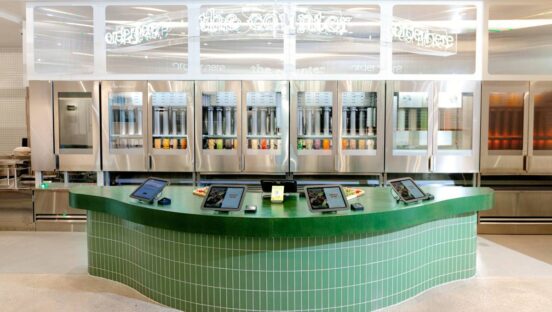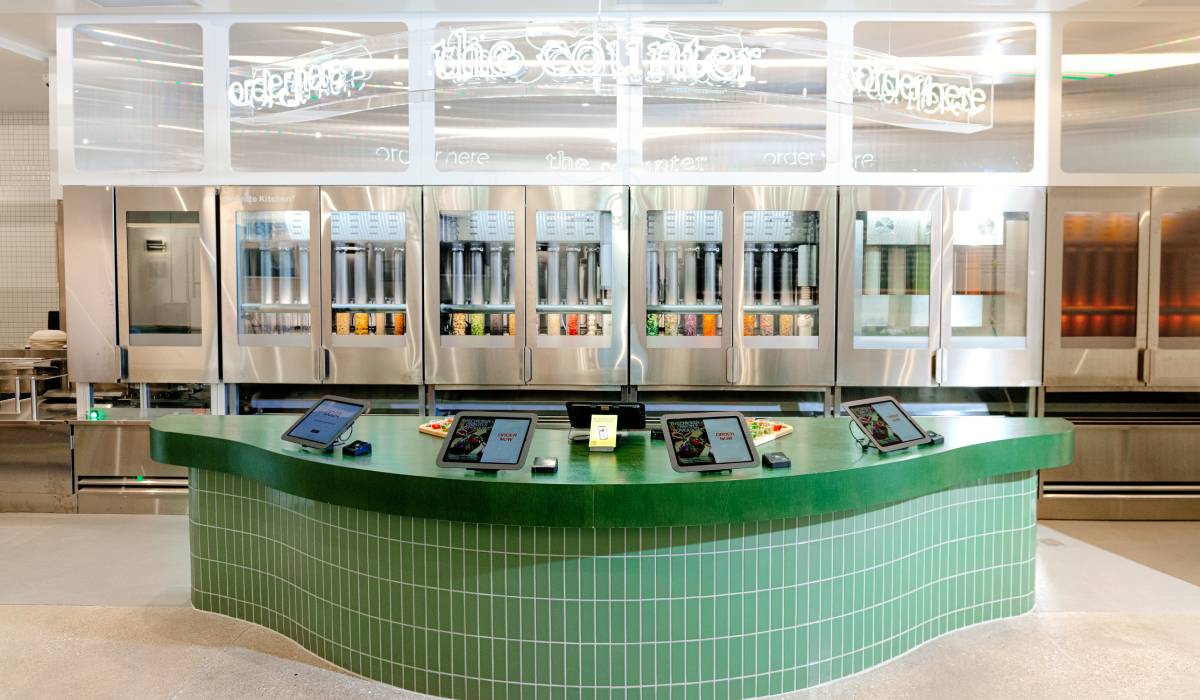Less than six months after launching its first Infinite Kitchen in Naperville, Illinois, sweetgreen is putting the pieces in place to staff more restaurants with the salad-making robot.
The assembly line engine dispenses ingredients along a conveyor belt and produces up to 500 bowls, plates, and sides per hour, which is 50 percent more than a typical restaurant’s front and digital make line combined. CEO Jonathan Neman said the pilot is delivering multiple benefits to the operating model, including increased throughput and portioning consistency along with “near perfect” order accuracy. Around half of sweetgreen’s variable labor in restaurants is production- or assembly-related, so the technology is freeing up workers to focus more on customer experiences, too.
“The feedback we hear consistently is that we are delivering a much better customer experience,” Neman said during the company’s Q3 earnings call in early November. “People love it. They love the speed. They love the cleanliness and the hospitality experience we’re able to bring.”
The store in Naperville is seeing lower turnover, with team members reporting the Infinite Kitchen creates a more enjoyable work environment, he added. It’s also seeing significant margin leverage. The company didn’t provide any updates on the store’s performance, but Neman said it delivered a 26 percent margin in June. That’s higher than the typical new store, which usually is well below 20 percent in the first month.
A second automated restaurant will open in Huntington Beach, California, in December. The company is moving into an initial production phase with an equipment manufacturer and plans to deploy seven to nine Infinite Kitchens in new units next year. The goal is to test the technology in a variety of restaurants, including suburban and urban locations, to see how it works in different types of real estate.
The automated units will be among the 23 to 28 new restaurants planned for 2024, down from the 38 new restaurants expected in 2023. The reason for the slowdown is to better integrate the technology into the pipeline.
“We will begin to deploy the Infinite Kitchen in the back of the year, and we want to better integrate that, so we don’t have to go back and do as many retrofits,” Neman said.
The company expects to ramp up development the following year and hopes, based on the success of the deployments, to have a greater share of Infinite Kitchens in the 2025 pipeline. It also plans to retrofit two to four existing units with automated make lines next year. The retrofits will occur in high-volume urban stores, where sweetgreen is most interested in understanding how faster throughput will translate into higher revenue and thus a higher return on capital.
“We’re looking to learn a few things in a retrofit that I think will be different from a new store,” Neman said. “Specifically, what does that max throughput do to our AUV in the restaurant? Think about a central business district store that has a really high peak demand. Can we not only get the margin leverage, but can we also capture more demand in those restaurants, and of course, have a better consistent experience?”
READ MORE:
Sweetgreen’s Infinite Kitchen Widens Path to Profitability
Sweetgreen CEO: All Stores will be Automated in Five Years
Sweetgreen to Launch Long-Awaited Automated Kitchen
Many existing restaurants could be retrofitted with the technology down the line, he added.
“It’s quite modular in terms of layout, it can be square or it can be linear, and it can be quite modular in terms of components to scale costs up or down, depending on the AUV,” he said. “There’s a lot of flexibility with the machine.”
He declined to talk about the exact cost of the technology but said the deployments will be accretive to sweetgreen’s return on capital, and there will be economies of scale as the chain opens more automated units.
“We have two cost curves going,” Neman said. “One is significant inflation on the labor side, while the cost of technology will come down. Over time, this can become a very powerful tool for us, especially as we see significant wage increases across the country.”
Sweetgreen is finding other opportunities besides the Infinite Kitchen to create a “five-star team member experience” and make the work “easier, simpler, and faster” in traditional, non-automated stores, he added. It recently removed the prep of five of the most popular dressings from its restaurants. That might seem like a small initiative on the surface, but Neman said it was a “years-long decision” aimed at eliminating a key point of friction for employees. The move is allowing team members to shift their focus away from prepping some of the most intensive recipes and focus instead on hospitality and throughput.
Labor-related costs were 29 percent of revenue in Q3, down 200 basis points from the same period a year ago. The company attributed the improvement to a tighter labor model and head coach scheduling optimization.
”Our business is all about seconds and cents, so we’ve really been working towards pulling all the levers we have,” Neman said. “In terms of the labor specifically, the gains have been around better deploying it. Some of it has been having our head coaches working more time on the floor, consistent with the rest of the industry. Although it’s been getting tighter with our labor deployment models, we have also seen a pretty significant increase in our head cook stability.”
Turnover has decreased 15 percent since the start of the year and is expected to continue declining in the coming quarters thanks to additional initiatives, like the introduction of tipping in Q3 and ongoing investments in training.
“As our teams get more time enrolled, they are more productive, not only in providing a better experience, but a more profitable experience,” Neman said.
Labor adjustments and efforts to maximize throughput are pushing sweetgreen further along the path toward profitability. The company narrowed its net loss in Q3 to $25.1 million from $55 million a year ago. Same-store sales were up 4 percent, driven by 5 percent pricing and partially offset by a 1 percent decline in traffic/mix. CFO Mitch Reback attributed the mix offset to channel movement into the front line and pickup from native delivery. Digital orders accounted for 58 percent of revenue, with two-thirds of those sales coming through sweetgreen’s owned digital channels. Restaurant-level margin was 19 percent, a 300 basis point improvement from Q3 of 2022, due to menu price increases as well as improvements in supply chain sourcing and labor optimization.
The sales growth and restaurant-level margin expansion, along with more disciplined support center spend, resulted in an adjusted EBITDA of $2.5 million in Q3. That marks sweetgreen’s second positive adjusted EBITDA quarter since it went public in 2021. Its adjusted EBITDA loss is under $1 million on a year-to-date basis, a $31 million improvement over the same period a year ago. Phrased differently, Neman said over 40 percent of each incremental dollar of revenue is flowing through to the bottom line.
“Sometimes the progress in a business is not always visible to the outside world, and in many ways, off the back of COVID, we had to spend more time stabilizing our company than building it,” he said. “While we waited for the world to return, albeit somewhat slower than we would have liked, we spent time strengthening the foundation of our business, tackling our costs, and focusing on driving margin expansion… While we still find ourselves in a complex and shifting environment, what I can say for certain is that we are back on the offensive.”
He pointed to loyalty and menu innovation as two key areas of focus that could drive significant revenue gains going forward.
Sweetpass, a two-tiered loyalty program that debuted this spring, grew its membership base by 25 percent in Q3. The program features a free component and a paid component called Sweetpass Plus, where guests receive $3 off daily sweetgreen orders, priority customer support, delivery perks, premier access to merch drops, and other exclusive experiences for $10 a month. It was only available for digital orders until September. Now, members can earn and redeem rewards in-store by scanning a QR code at the register.
Neman said sweetgreen is seeing “some nice incrementality” out of the program and expects to beat its internal enrollment targets for the year.
“I do believe there is a lot of opportunity for us to make minor tweaks around how we leverage the CRM and the different customer journeys to see more incrementality out of that,” he said. “So, as we look forward to 2024 and the comps drivers for us, continuing to optimize and leverage Sweetpass is very high on the list.”
On the menu front, sweetgreen late last month debuted a new line of protein plates that marked its biggest launch in several years. The new plates come in three varieties–Miso Glazed Salmon, Southwest Chicken Fajita, and Hot Honey Chicken–that each offer 30 to 50 grams of protein and a double portion of grains.
The protein plates are geared toward growing traffic during the evening daypart, which currently accounts for around 35 percent of sweetgreen’s business.
“There are many people that want to eat healthy, real, delicious, craveable food, but may not want to eat a salad all the time, so this starts to capture that broader consumer,” Neman said. “It removes the veto vote in many cases. We see a huge opportunity in growing share at dinner and balancing that out, and that should be really accretive to our unit-level economics.”
The product mix already is exceeding expectations and doubling forecasts in some markets, he added.
“This is just the beginning of building out this category,” Neman said. “You could expect us over the coming quarters and years to continue to build on top of this. Think about different unique base options and other proteins that will build onto it. And over time, I see protein plates really broadening the consumer, helping us win dinner, and really helping us increase the total addressable market of the business.”
The company anticipates finishing 2023 with 35 net new restaurant openings, same-store sales growth between 3 and 5 percent, adjusted EBITDA loss between $8 million and $3 million, and restaurant-level margins between 16.5 and 17.5 percent.
Looking ahead to 2024, Reback said sweetgreen is on track to reach its goal of generating positive adjusted EBITDA on a full-year basis. Its 20 percent restaurant-level margin target is well within sight, too.
“As we look out on the things that we have discussed earlier—both on the cost structure side around labor optimization, and on the growth side around menus, Sweetpass, and Sweetpass Plus—we see drivers to increase revenues and costs coming down,” he said. “We think it’s clearly a path to 20 percent in the near term, and that’s without any benefit from the Infinite Kitchen, which, quite frankly, could be transformational over the next few years.”








